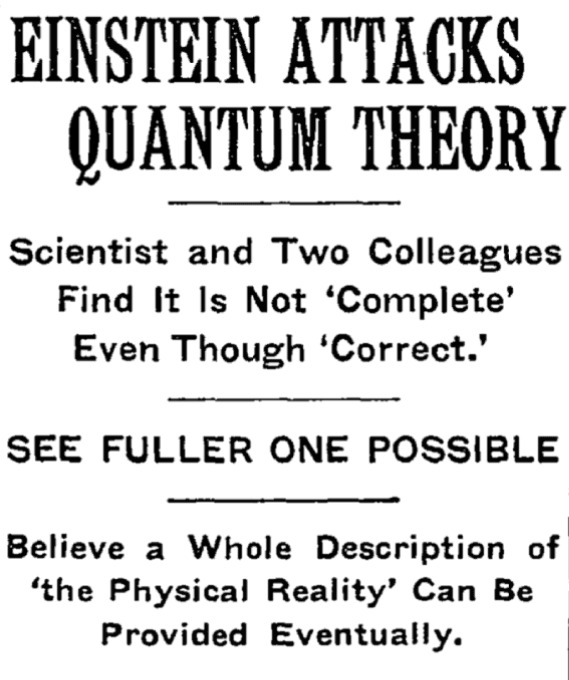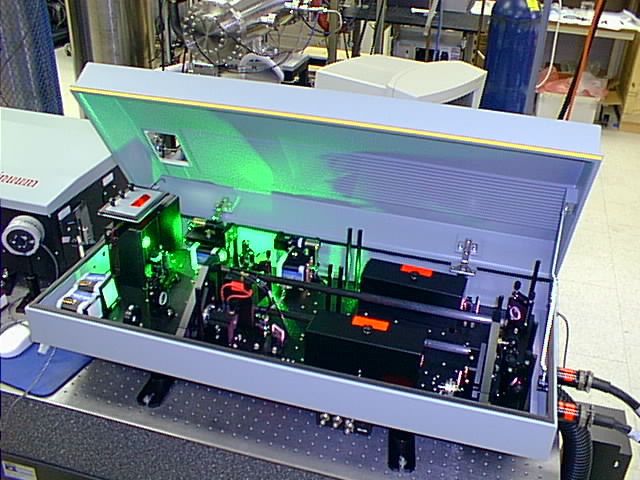|
Optical Parametric Oscillation
An optical parametric oscillator (OPO) is a parametric oscillator that oscillates at optical frequencies. It converts an input laser wave (called "pump") with frequency \omega_p into two output waves of lower frequency (\omega_s, \omega_i) by means of second- order nonlinear optical interaction. The sum of the output waves' frequencies is equal to the input wave frequency: \omega_s + \omega_i=\omega_p. For historical reasons, the two output waves are called "signal" and "idler", where the output wave with higher frequency is the "signal". A special case is the degenerate OPO, when the output frequency is one-half the pump frequency, \omega_s=\omega_i=\omega_p/2, which can result in half-harmonic generation when signal and idler have the same polarization. The first optical parametric oscillator was demonstrated by Joseph A. Giordmaine and Robert C. Miller in 1965, five years after the invention of the laser, at Bell Labs. Optical parametric oscillators are used as coherent light s ... [...More Info...] [...Related Items...] OR: [Wikipedia] [Google] [Baidu] |
Periodical Poling
Periodic poling is a formation of layers with alternate orientation in a birefringent material. The domains are regularly spaced, with period in a multiple of the desired wavelength of operation. The structure is designed to achieve quasi-phase-matching (QPM) in the material. Periodically poled crystals are frequently used as nonlinear optical materials. They are more efficient at second-harmonic generation than crystals of the same material without periodic structure. The material for the crystals is usually a wide band gap inorganic crystal, or in some cases a suitable organic polymer. Some popular materials in current use are potassium titanyl phosphate (KTP), lithium niobate, and lithium tantalate. The periodic structure is created in the crystal using a range of techniques. Pulsed electric field, electron bombardment, thermal pulsing, or other methods can be used to reposition the atoms in the lattice Lattice may refer to: Arts and design * Latticework, an ornamental cris ... [...More Info...] [...Related Items...] OR: [Wikipedia] [Google] [Baidu] |
Hardware Random Number Generator
In computing, a hardware random number generator (HRNG) or true random number generator (TRNG) is a device that generates random numbers from a physical process, rather than by means of an algorithm. Such devices are often based on microscopic phenomena that generate low-level, statistically random "noise" signals, such as thermal noise, the photoelectric effect, involving a beam splitter, and other quantum phenomena. These stochastic processes are, in theory, completely unpredictable for as long as an equation governing such phenomena is unknown or uncomputable. This is in contrast to the paradigm of pseudo-random number generation commonly implemented in computer programs. A hardware random number generator typically consists of a transducer to convert some aspect of the physical phenomena to an electrical signal, an amplifier and other electronic circuitry to increase the amplitude of the random fluctuations to a measurable level, and some type of analog-to-digital conv ... [...More Info...] [...Related Items...] OR: [Wikipedia] [Google] [Baidu] |
Spontaneous Parametric Down Conversion
Spontaneous parametric down-conversion (also known as SPDC, parametric fluorescence or parametric scattering) is a nonlinear instant optical process that converts one photon of higher energy (namely, a pump photon), into a pair of photons (namely, a signal photon, and an idler photon) of lower energy, in accordance with the law of conservation of energy and law of conservation of momentum. It is an important process in quantum optics, for the generation of entangled photon pairs, and of single photons. Basic process A nonlinear crystal is used to produce pairs of photons from a photon beam. In accordance with the law of conservation of energy and law of conservation of momentum, the pairs have combined energies and momenta equal to the energy and momentum of the original photon. Because the index of refraction changes with frequency (dispersion), only certain triplets of frequencies will be phase-matched so that simultaneous energy and momentum conservation can be achieved. P ... [...More Info...] [...Related Items...] OR: [Wikipedia] [Google] [Baidu] |
Quantum Entanglement
Quantum entanglement is the phenomenon that occurs when a group of particles are generated, interact, or share spatial proximity in a way such that the quantum state of each particle of the group cannot be described independently of the state of the others, including when the particles are separated by a large distance. The topic of quantum entanglement is at the heart of the disparity between classical and quantum physics: entanglement is a primary feature of quantum mechanics not present in classical mechanics. Measurements of physical properties such as position, momentum, spin, and polarization performed on entangled particles can, in some cases, be found to be perfectly correlated. For example, if a pair of entangled particles is generated such that their total spin is known to be zero, and one particle is found to have clockwise spin on a first axis, then the spin of the other particle, measured on the same axis, is found to be anticlockwise. However, this behavior gives ... [...More Info...] [...Related Items...] OR: [Wikipedia] [Google] [Baidu] |
Squeezed Coherent States
In physics, a squeezed coherent state is a quantum state that is usually described by two Commutator, non-commuting Observable, observables having continuous spectra of Eigenvalues and eigenvectors, eigenvalues. Examples are position x and momentum p of a particle, and the (dimension-less) electric field in the amplitude X (phase 0) and in the mode Y (phase 90°) of a light wave (the wave's Optical phase space, quadratures). The product of the standard deviations of two such Operator (physics), operators obeys the uncertainty principle: :\Delta x \Delta p \geq \frac2\; and \;\Delta X \Delta Y \geq \frac4 , respectively. Trivial examples, which are in fact not squeezed, are the ground state , 0\rangle of the quantum harmonic oscillator and the family of coherent states , \alpha\rangle. These states saturate the uncertainty above and have a symmetric distribution of the operator uncertainties with \Delta x_g = \Delta p_g in "natural oscillator units" and \Delta X_g = \ ... [...More Info...] [...Related Items...] OR: [Wikipedia] [Google] [Baidu] |
OPO Crystals
{{disambig ...
"OPO" or "Opo" can refer to: *OnePlus One, a smartphone model produced by the Chinese company OnePlus *Optical parametric oscillator *Francisco de Sá Carneiro Airport, known by IATA code OPO *Organ procurement organization, which helps to arrange organ donation *One-man operation, also known as one person operation in road passenger transport where a driver of a vehicle has sole responsibility for operating the vehicle *Lagenaria siceraria, a squash commonly known as opo *Opo the Dolphin, a famous dolphin in New Zealand *Online Presence Ontology *Orlando Philharmonic Orchestra *Orlando Pops Orchestra *Ovamboland People's Organization The Ovamboland People's Organization (OPO) was a nationalist organization that existed between 1959 and 1960 in South West Africa (now present day Namibia Namibia (, ), officially the Republic of Namibia, is a country in Southern Africa. It ... [...More Info...] [...Related Items...] OR: [Wikipedia] [Google] [Baidu] |
Brian Orr
Brian J. Orr is an Australian scientist known for various experimental and theoretical contributions to molecular and optical physics, including laser spectroscopy and optical parametric oscillators. Biography Born in 1942, Orr grew up in Sydney and graduated with BSc (Hons I) and MSc from the University of Sydney. He received his PhD from the University of Bristol (UK) in 1968 and, after a postdoctoral period in Ottawa (Canada), returned to Sydney in 1969 to take up an academic position at the University of New South Wales. In 1988, he became Professor of Chemistry in the Faculty of Science at Macquarie University. Since 2003, Orr has been an Emeritus Professor, based in Macquarie University’s Department of Physics and Astronomy. His roles at Macquarie University have included service as Head of School/Department (1989–92/1999–2002), as Deputy Chair of the Academic Senate (1989–92), and as a member of the University Council (1999–2002). He is Founding Director (2007–2 ... [...More Info...] [...Related Items...] OR: [Wikipedia] [Google] [Baidu] |
CRC Press
The CRC Press, LLC is an American publishing group that specializes in producing technical books. Many of their books relate to engineering, science and mathematics. Their scope also includes books on business, forensics and information technology. CRC Press is now a division of Taylor & Francis, itself a subsidiary of Informa. History The CRC Press was founded as the Chemical Rubber Company (CRC) in 1903 by brothers Arthur, Leo and Emanuel Friedman in Cleveland, Ohio, based on an earlier enterprise by Arthur, who had begun selling rubber laboratory aprons in 1900. The company gradually expanded to include sales of laboratory equipment to chemists. In 1913 the CRC offered a short (116-page) manual called the ''Rubber Handbook'' as an incentive for any purchase of a dozen aprons. Since then the ''Rubber Handbook'' has evolved into the CRC's flagship book, the '' CRC Handbook of Chemistry and Physics''. In 1964, Chemical Rubber decided to focus on its publishing ventures ... [...More Info...] [...Related Items...] OR: [Wikipedia] [Google] [Baidu] |
Coherent State
In physics, specifically in quantum mechanics, a coherent state is the specific quantum state of the quantum harmonic oscillator, often described as a state which has dynamics most closely resembling the oscillatory behavior of a classical harmonic oscillator. It was the first example of quantum dynamics when Erwin Schrödinger derived it in 1926, while searching for solutions of the Schrödinger equation that satisfy the correspondence principle. The quantum harmonic oscillator (and hence the coherent states) arise in the quantum theory of a wide range of physical systems.J.R. Klauder and B. Skagerstam, ''Coherent States'', World Scientific, Singapore, 1985. For instance, a coherent state describes the oscillating motion of a particle confined in a quadratic potential well (for an early reference, see e.g. Schiff's textbook). The coherent state describes a state in a system for which the ground-state wavepacket is displaced from the origin of the system. This state can be relate ... [...More Info...] [...Related Items...] OR: [Wikipedia] [Google] [Baidu] |
Nd-YAG Laser
Nd:YAG (neodymium-doped yttrium aluminum garnet; Nd:Y3Al5O12) is a crystal that is used as a lasing medium for solid-state lasers. The dopant, triply ionized neodymium, Nd(III), typically replaces a small fraction (1%) of the yttrium ions in the host crystal structure of the yttrium aluminum garnet (YAG), since the two ions are of similar size.Koechner §2.3, pp. 48–53. It is the neodymium ion which provides the lasing activity in the crystal, in the same fashion as red chromium ion in ruby lasers. Laser operation of Nd:YAG was first demonstrated by J.E. Geusic ''et al.'' at Bell Laboratories in 1964. Technology Nd: YAG lasers are optically pumped using a flashtube or laser diodes. These are one of the most common types of laser, and are used for many different applications. Nd:YAG lasers typically emit light with a wavelength of 1064 nm, in the infrared. However, there are also transitions near 946, 1120, 1320, and 1440 nm. Nd:YAG lasers operate in both pulsed and c ... [...More Info...] [...Related Items...] OR: [Wikipedia] [Google] [Baidu] |
Lithium Niobate
Lithium niobate () is a non-naturally-occurring salt consisting of niobium, lithium, and oxygen. Its single crystals are an important material for optical waveguides, mobile phones, piezoelectric sensors, optical modulators and various other linear and non-linear optical applications. Lithium niobate is sometimes referred to by the brand name linobate. Properties Lithium niobate is a colorless solid, and it is insoluble in water. It has a trigonal crystal system, which lacks inversion symmetry and displays ferroelectricity, the Pockels effect, the piezoelectric effect, photoelasticity and nonlinear optical polarizability. Lithium niobate has negative uniaxial birefringence which depends slightly on the stoichiometry of the crystal and on temperature. It is transparent for wavelengths between 350 and 5200 nanometers. Lithium niobate can be doped by magnesium oxide, which increases its resistance to optical damage (also known as photorefractive damage) when doped above the optica ... [...More Info...] [...Related Items...] OR: [Wikipedia] [Google] [Baidu] |





